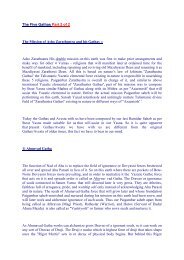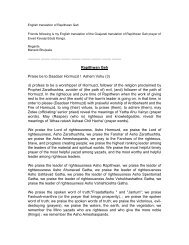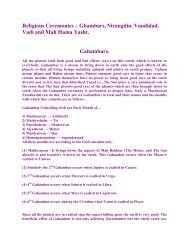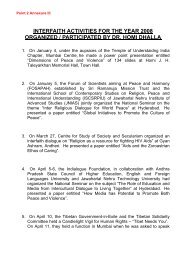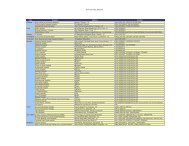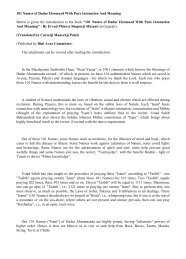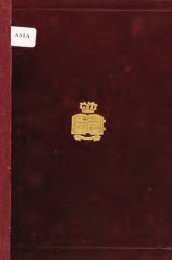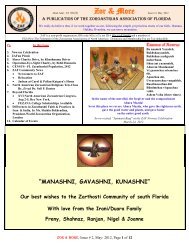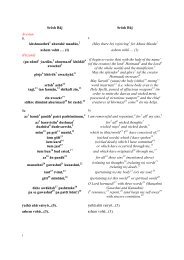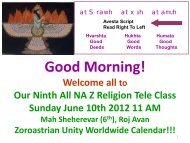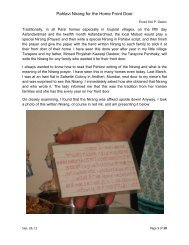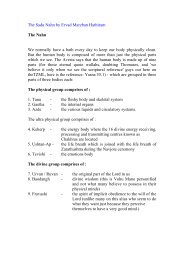Jal F Dastur: Parsee patriarch - WordPress â www.wordpress.com
Jal F Dastur: Parsee patriarch - WordPress â www.wordpress.com
Jal F Dastur: Parsee patriarch - WordPress â www.wordpress.com
You also want an ePaper? Increase the reach of your titles
YUMPU automatically turns print PDFs into web optimized ePapers that Google loves.
uganda asians<br />
<strong>Jal</strong> F <strong>Dastur</strong>: <strong>Parsee</strong> <strong>patriarch</strong><br />
Arrived Uganda: 1923<br />
Died: August 1991, Vancouver, British Columbia<br />
Family: Wife Threaty (died 1974 Vancouver);<br />
daughter Roda (died 1987, Vancouver ); daughter<br />
Piroj Amrolia and son Nanu <strong>Dastur</strong> live in<br />
Vancouver.<br />
The account below is in the late Mr <strong>Jal</strong> F <strong>Dastur</strong>’s own<br />
words (from notes left with his daughter Piroj Amrolia<br />
and given to VIVJ at Vancouver, April 2010). Reproduction<br />
here is after some minimal paraphrasing and<br />
editing.<br />
the ginnery in Bugerere District died and I was<br />
asked to take over his functions. I had enough<br />
of this after three years, and on a trip to India I<br />
decided to call it quits but had to reconsider as<br />
I had my mother and sisters to support. On my<br />
return I found Narandas Rajaram had acquired two<br />
more ginneries (at Kidzi and Kaboyo) from four<br />
Europeans who had defaulted on their loan from<br />
their <strong>com</strong>pany. I was put in charge of those two<br />
ginneries as well as one at Kyabakuza which belonged<br />
to Janmohamed Allidina but was financed<br />
by NR Co.<br />
My father Fakirji <strong>Dastur</strong> passed away at the age of 53 due<br />
to a stroke, leaving behind him three boys and three girls in<br />
the care of my mother. The only help my mother had was<br />
from my two elder step-brothers, one of them Pesi <strong>Dastur</strong>,<br />
who had <strong>com</strong>e to Uganda in 1908 before me and died at<br />
the young age of 33.<br />
In 1923 I saw an ad in the Times of India by M/s Narandas<br />
Rajaram Co Ltd: “Wanted for Uganda, Africa,<br />
young hard working, knowing accounts and<br />
other work. Good prospects.” The <strong>com</strong>pany<br />
dealt in cotton. I paid them a visit in Bombay and accepted<br />
their job offer. I sailed for Africa on May 5, 1923 in<br />
a steamship named SS Taroba. The voyage lasted eleven<br />
days. I was met at Mombasa by a relative, Sorabji Hooker,<br />
and proceeded to Kampala by train via Kisumu, which<br />
then was the terminal point for the Uganda Railway. From<br />
Kisumu I took a boat to Port Bell, a journey of two nights.<br />
I just loved the beauty of Uganda and its islands, the lake<br />
teeming with hippos and crocodiles.<br />
My employers posted me to their ginnery in Kawempe<br />
and after eighteen months transferred me to their ginnery<br />
in Namasumbi. The conditions of work were hard and I<br />
only came through because of my faith in prayers. My luck<br />
changed out of an adversity when the manager minding<br />
On my visit to India in 1929, I got married to<br />
Threaty Bhagulia. We set up our first home – two<br />
bedrooms – of galvanized corrugated iron sheets<br />
(GCI) sheets. Our first daughter Roda was born<br />
in 1931, second daughter Piroj in 1934 and son<br />
Nanu in 1940. During our stay in Kidzi there were<br />
only eight other Asian families there, six working<br />
at the ginnery and two running dukas (shops).<br />
The closest town was Masaka, ten miles away. My<br />
children were home-tutored and home-doctored.<br />
In fact locals came every morning to seek medical<br />
help from my wife. Both she and I participated in<br />
Masaka’s public life.<br />
My association with Narandas Rajaram Co ended<br />
in 1944 when I partnered with Suleman Verjee &<br />
Bros in their ginneries at Bilawri and Kasozi in<br />
Busoga District, near Jinja. My wife stayed on in<br />
Jinja to educate our children. I was also partners<br />
with Mawji Karim & Sons Ltd in their produce<br />
business and with M/s Navivumbi Timber Co Ltd.<br />
The <strong>com</strong>pany owned large forests of Mvule and<br />
Mahogany trees.<br />
In 1946 I ventured on my own and moved to Kampala.<br />
The <strong>com</strong>pany was first registered as Colonial<br />
Distributors Ltd to import general goods and later changed the<br />
name to <strong>Dastur</strong> Ltd. I was the sole agent for British India General<br />
Insurance Co Ltd with responsibilities for the whole East African<br />
region.<br />
Many of my intended projects failed to materialize because of<br />
“Amin” – the 1971 coup and the 1972 expulsion. My <strong>com</strong>pany<br />
was the agent of M/s Godrej & Boyce of Bombay, importing steel<br />
furniture. My son Nanu was in-charge of this department. In 1968 I<br />
decided to establish an assembly plant for steel furniture in Uganda<br />
in partnership with Godrej & Boyce and the Madhvani Group. The<br />
land and the required licences were secured after much red-tape,<br />
but Godrej & Boyce became uneasy about the political situation<br />
in Uganda. In 1969 I floated a <strong>com</strong>pany in the name of Central<br />
Properties Ltd to specialize in property development. The 13 partners<br />
each subscribed one lakh shillings (Sh1,00,000; sic about the<br />
<strong>com</strong>mas). Plots and loan were acquired with the intention to build<br />
an 11-storey highrise office building opposite the High Court. Amin<br />
intervened. The same story and fate befell a partnership project<br />
with Mr Jack Sentongo (later Finance Minister, 1979/80) for a<br />
galvanizing plant – licence secured after much difficulty, loan lined<br />
up, Amin coup intervened.<br />
I was the first person from the Asian <strong>com</strong>munity to join the Democratic<br />
Party when it opened up to Asians. I contributed to its fund-<br />
We contributed, we contribute<br />
308
uganda asians<br />
ing. I was invited by party chairman Mr Ben Kiwanuka to<br />
stand for elections in 1960. I was defeated by a few votes,<br />
due to last-minute manoeuvring by my opponent. During<br />
the second election, Apollo Milton Obote invited me to<br />
join the UPC but I declined as it could affect my business<br />
prospects.<br />
Among my achievements I am most proud of my services<br />
to our <strong>com</strong>munity. I was the founding member of the<br />
Zoroastrian Association of <strong>Parsee</strong>s of Uganda in 1926,<br />
starting as Honorary Secretary and then President. By<br />
The impeccable CV<br />
(from notes given by Piroj Amrolia)<br />
Trade and Commerce: Government<br />
Sole Price Fixing Committee Member, WWII<br />
Member of Whisky and Liquor Board<br />
Advisory Board of Ministry of Commerce and Industry<br />
Senior Vice President of Uganda Chamber of Commerce<br />
Hon Sec and Vice President of Indian Chamber of Commerce<br />
Member and rapporteur of Uganda Trade Delegation to India<br />
• Board of East African Railways and Harbours; and East African Tele<strong>com</strong>munications<br />
the early 1950s it was realized that the <strong>com</strong>munity had to<br />
have its own burial ground. This was acquired in 1953 at<br />
the nominal rent of two shillings per year. I acted as the<br />
<strong>com</strong>munity priest.<br />
When the expulsion came I was still an active member<br />
of several chambers of <strong>com</strong>merce, school boards and the<br />
Indian Association. My last duty to the Asian <strong>com</strong>munity<br />
was as an advisor to the Coordination Committee for the<br />
Refugees. My wife and I left Uganda to settle in Canada<br />
with my children.”<br />
Associations<br />
• Hon Secretary of Indian Association, Masaka; Hon Secretary of Indian Association, Kampala; and<br />
Hon Secretary of Central Council of Indian Associations of Uganda<br />
Founding member of Tenants Association. Member of Rent Control Board<br />
• Councillor on Kampala Municipal Council, pre-Independence. Chairman of Administration and Finance<br />
Committee; Alderman for six years<br />
• Jury and assessor service in important cases, such the Armoury Case<br />
Education<br />
Member (with Mrs Threaty <strong>Dastur</strong>) of District Education Board for Masaka District<br />
Member of Kampala and District Education Board<br />
• Member of school boards: Kampala Municipal Council School; City High School (created on Mr <strong>Dastur</strong>’s<br />
“coffee table”; admitted many African students free of charge); Nakasero European School (only<br />
Asian member ever); Nakivubo High School (largest school in Kampala with 1,800 pupils)<br />
Audience with World’s Who’s Who<br />
HM the Queen and Duke of Edinburgh; Princess Margaret and Lord Snowden; Pope Pius; HH Aga Khan<br />
IV and Begum; His Holiness Dai of the Bohra Community; Jawaharlal Nehru (in Bombay); all governors<br />
of Uganda; all High Priests of all Asian <strong>com</strong>munities.<br />
MrsThreaty<br />
<strong>Dastur</strong>:<br />
In her own right<br />
(from notes given by<br />
daughter Piroj Amrolia,<br />
Vancouver, Nov 2010)<br />
Mrs Threaty <strong>Dastur</strong><br />
came to Uganda in 1929<br />
upon her marriage to Mr<br />
<strong>Jal</strong> <strong>Dastur</strong>. They were<br />
initially based at Masaka<br />
in a ginnery owned by<br />
Narandas Rajaram & Co.<br />
She became a member<br />
of the Masaka District<br />
Education Board. The experience<br />
gained from this<br />
appointment propelled<br />
her to serve the needy.<br />
In Kampala she was a<br />
member on the Executive<br />
Committee of the Indian<br />
Association and treasurer<br />
of their nursery school.<br />
She sat on the Executive Committee<br />
of the <strong>Parsee</strong> Zoroastrian<br />
Anjuman from 1952 to 1961. She<br />
served on Uganda Red Cross as<br />
a treasurer, the Salvation Army,<br />
the YWCA, and Women’s Corona<br />
Society that helped women and<br />
We contributed, we contribute<br />
309
uganda asians<br />
children in crisis. She worked on the Free Scholarship<br />
Committee to raise funds to subsidize poor<br />
children’s education. She sat on the board of the<br />
Family Planning Association of Uganda, representing<br />
the organization at the 17th International Conference<br />
in Delhi. She met Prime Minister Mrs Indira<br />
Gandhi. Possibly her most satisfying work was with<br />
the Uganda Council of Women as its treasurer from<br />
1948 to 1968. The council assisted women in establishing<br />
in business.<br />
In 1972, despite the turmoil and chaos of the expulsion,<br />
Threaty worked tirelessly to ensure that Asian<br />
people with limited means could travel out to their<br />
diaspora countries.<br />
Hers was a life of <strong>com</strong>mitment to the <strong>com</strong>munity<br />
with a passion. She understood the importance of<br />
a small gesture in making or breaking a project. In<br />
particular that to rescue children in need is to ensure<br />
the survival of the society itself.<br />
L2R: Ramakant; Chief Justice of India and Madam; Mr Singh, High Commissioner of India; <strong>Jal</strong> <strong>Dastur</strong><br />
We contributed, we contribute<br />
310



